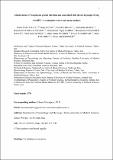Files in this item
Global status of Toxoplasma gondii infection and associated risk factors in people living with HIV : a systematic review and meta-analysis
Item metadata
| dc.contributor.author | Safarpour, Hanie | |
| dc.contributor.author | Cevik, Muge | |
| dc.contributor.author | Zarean, Mehdi | |
| dc.contributor.author | Barac, Aleksandra | |
| dc.contributor.author | Hatam-Nahavandi, Kareem | |
| dc.contributor.author | Rahimi, Mohammad Taghi | |
| dc.contributor.author | Bannazadeh Baghi, Hossein | |
| dc.contributor.author | Koshki, Tohid Jafari | |
| dc.contributor.author | Pagheh, Abdol Sattar | |
| dc.contributor.author | Shahrivar, Firooz | |
| dc.contributor.author | Ebrahimi, Mina | |
| dc.contributor.author | Ahmadpour, Ehsan | |
| dc.date.accessioned | 2020-11-09T00:38:26Z | |
| dc.date.available | 2020-11-09T00:38:26Z | |
| dc.date.issued | 2020-03-01 | |
| dc.identifier | 263235541 | |
| dc.identifier | 79f963d7-1d39-4d53-a7fb-a8c0c3a518c5 | |
| dc.identifier | 31714356 | |
| dc.identifier | 85078693420 | |
| dc.identifier | 000544898400014 | |
| dc.identifier.citation | Safarpour , H , Cevik , M , Zarean , M , Barac , A , Hatam-Nahavandi , K , Rahimi , M T , Bannazadeh Baghi , H , Koshki , T J , Pagheh , A S , Shahrivar , F , Ebrahimi , M & Ahmadpour , E 2020 , ' Global status of Toxoplasma gondii infection and associated risk factors in people living with HIV : a systematic review and meta-analysis ' , AIDS , vol. 34 , no. 3 , pp. 469-474 . https://doi.org/10.1097/QAD.0000000000002424 | en |
| dc.identifier.issn | 0269-9370 | |
| dc.identifier.other | ORCID: /0000-0003-1133-3874/work/64698140 | |
| dc.identifier.uri | https://hdl.handle.net/10023/20925 | |
| dc.description.abstract | OBJECTIVE: Toxoplasma infection remains as the most common cause of focal brain lesions among people living with HIV (PLHIV) despite the decline in opportunistic infections with the introduction of antiretroviral treatment. This study was conducted to provide a summary of evidence about the seroprevalence of Toxoplasma gondii and prevalence of active T. gondii infection and associated risk factors among PLHIV. DESIGN: PRISMA guidelines were followed. Scopus, PubMed, Science Direct, and EMBASE were searched from 1997 to July 2018. All peer-reviewed original research articles describing T. gondii infection among PLHIV with different diagnostic methods were included. METHODS: Incoherence and heterogeneity between studies were quantified by I2 index and Cochran's Q test. Publication and population bias were assessed with funnel plots and Egger's regression asymmetry test. All statistical analyses were performed using StatsDirect. RESULTS: A total of 111 studies from 37 countries assessing 66,139 blood samples were included in this study. The pooled prevalence of T. gondii infection among PLHIV was 3.24% by IgM and 26.22% by molecular methods using the random-effects model. Pooled seroprevalence of T. gondii by IgG was 44.22%. There was a relationship between Toxoplasma prevalence and gender, raw meat consumption, contact with cat and knowledge about toxoplasmosis. CONCLUSION: High Toxoplasma seroprevalence among PLHIV observed in this study emphasizes the need for implementing screening and prophylaxis tailored to the local context. Owing to the serious and significant clinical manifestations of the parasite in case of reactivation, early identification of seropositivity for initiating prophylaxis among those with a CD4 count of <200cells/mL is recommended. | |
| dc.format.extent | 888810 | |
| dc.language.iso | eng | |
| dc.relation.ispartof | AIDS | en |
| dc.subject | AIDS | en |
| dc.subject | HIV | en |
| dc.subject | Immunocompromised | en |
| dc.subject | Prevalence | en |
| dc.subject | Toxoplasma gondii | en |
| dc.subject | Toxoplasmosis | en |
| dc.subject | QR180 Immunology | en |
| dc.subject | 3rd-DAS | en |
| dc.subject | SDG 3 - Good Health and Well-being | en |
| dc.subject.lcc | QR180 | en |
| dc.title | Global status of Toxoplasma gondii infection and associated risk factors in people living with HIV : a systematic review and meta-analysis | en |
| dc.type | Journal article | en |
| dc.contributor.institution | University of St Andrews. School of Medicine | en |
| dc.identifier.doi | https://doi.org/10.1097/QAD.0000000000002424 | |
| dc.description.status | Peer reviewed | en |
| dc.date.embargoedUntil | 2020-11-09 |
This item appears in the following Collection(s)
Items in the St Andrews Research Repository are protected by copyright, with all rights reserved, unless otherwise indicated.

